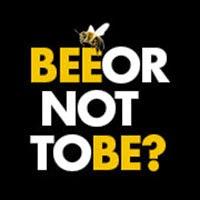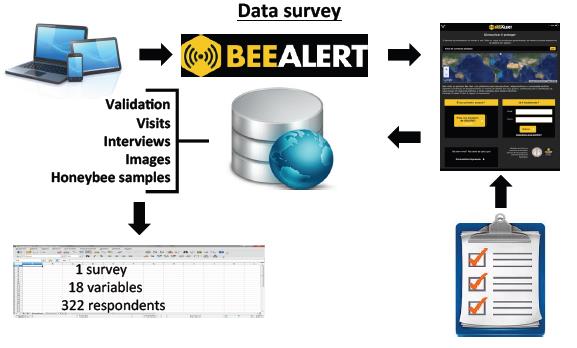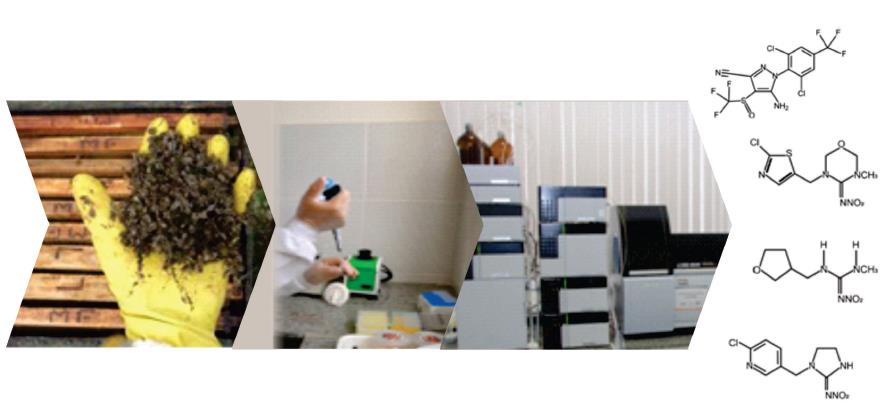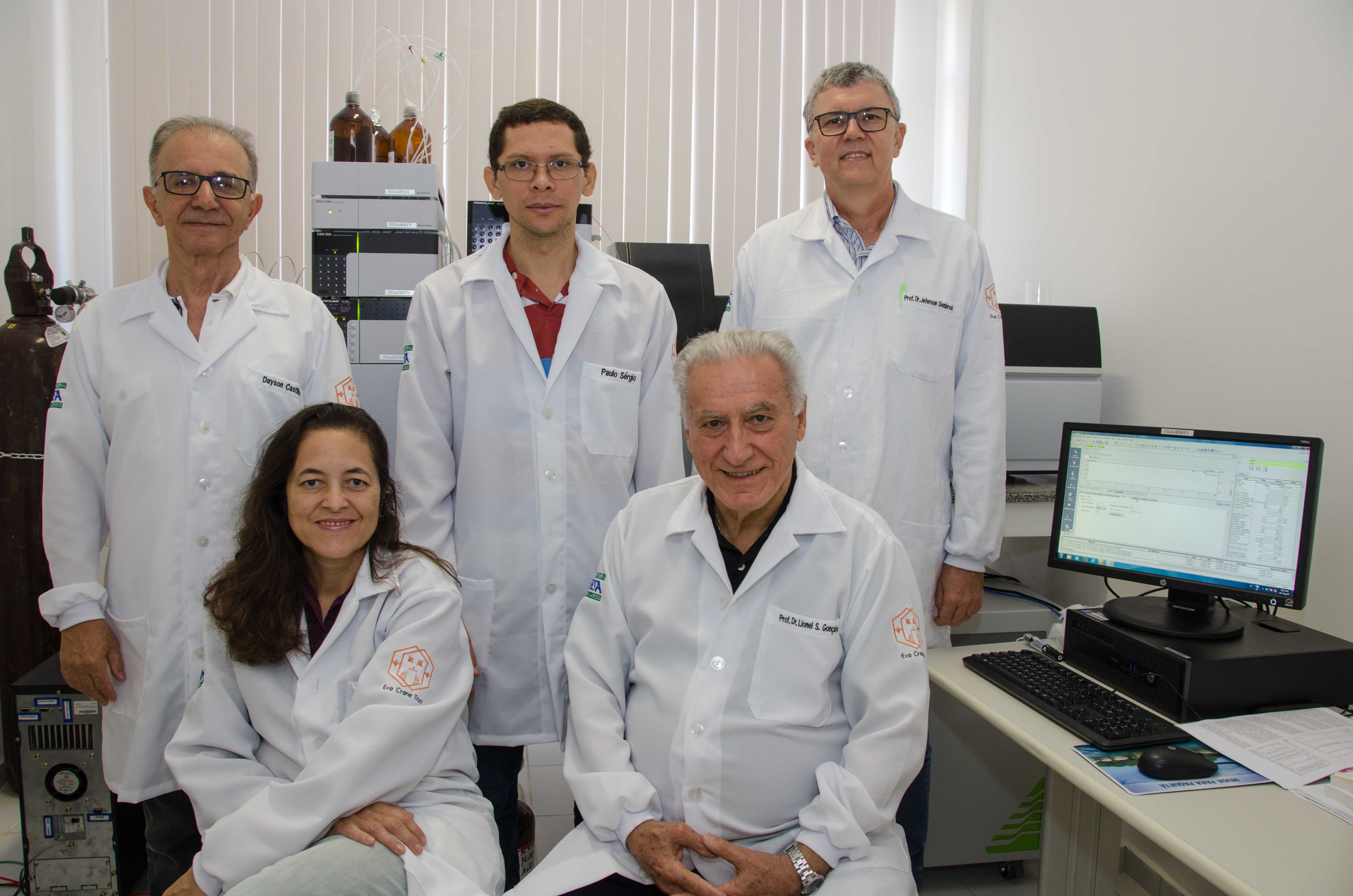Statistical and chemical analysis on Honeybee Samples collected in Brazil.
Statistical and chemical analysis on Honeybee Samples collected in Brazil.


A funding contribution from Eva Crane Trust, allowed the execution of original chemical analysis, the first made in an official university in Brazil, with modern and relevant scientific methodology adapted to the Brazilian Apicultural Environment, in UFERSA Phytopathology Laboratory, contributing to confirm the harmful effect of pesticides in bees in general, in the country, and consequently harmful for Brazilian beekeeping and stingless beekeeping.
Two major current problems of beekeeping are undoubtedly mass death and collapse or CCD (Colony Collapse Disorder) of bees, which have been causing a reduction in world populations of many species (Gill et al., 2012; Gonçalves, 2012a, b). These phenomena happen simultaneously in several countries, and they are of great concern to authorities and scientists worldwide (Krupke et al., 2012; Phillips, 2015). Since then, deaths and CCD have been reasons for research, concerns and losses, including in Brazil (De Jong, 2010; De Jong, Message, 2008; Gonçalves, 2012a, b; Imperatriz-Fonseca et al., 2012; Malaspina et al., 2008; Malaspina, Souza, 2008; Message, 2010; Pires et al., 2016).
This project considered two methods of analyses for deaths and CCD of bees in Brazil:
- Nationwide statistical analysis of colony losses. This was done with the support of the Non Governmental Organization BEE OR NOT TO BE. The leader, Prof. Dr. Lionel Segui Gonçalves, created an online application linked to the organization website www.nobeenofood.com/beealert, in which any collaborator could fill up a questionnaire, reporting colony losses. Data were confirmed, filtered and validated before being uploaded in databank. Data were used to do a statistical analysis of colony losses all around the country and fulfilled the first part of our project (Figure 1).
- The second part of the project intended to identify and quantify by high-performance liquid chromatography and mass spectrometry (UHPLC-MS/MS), residues of fipronil and neonicotinoid insecticides in live and dead Africanized honeybee samples collected during visits to the incident sites. This activity was granted by funds donated by Eva Crane Trust and confirmed the hypothesis that pesticides, with emphasis on neonicotinoid and fipronil insecticides, are the main cause of death and collapse of bee colonies in Brazil.

Figure 1: Nationwide statistical analysis of colony losses
Analyses were done in the Laboratory of Plant Ecophysiology at UFERSA – Universidade Federal Rural do Semi-Árido, Department of Plant Sciences using the QuEChERS (Quick Easy Cheap Effective Rugged Safe) method (Anastassiades et al., 2003), modified according to David et al. (2015) and adapted to local environmental conditions. Analyses were carried on in a high performance liquid chromatography (NEXERA X2 - Shimadzu UHPLC) combined with triple quadrupole mass spectrometry (LCMS-8040 - Shimadzu) (Figure 2). Method implementation was possible with the acquisition of chemical products, reagents, solvents and pesticide standards bought with the financial support granted by Eva Crane Trust. 
Figure 2 – Graphical abstract of honeybee sample analyses
Results of mass spectrometry analyses of live and dead honeybees collected in field scenarios confirmed the presence of neonicotinoid pesticides and fipronil at lethal levels for these insects according to the updated literature (>LD50). Agrochemicals have also been found at sublethal levels (<LD50), whose accumulation in organisms over time can lead honeybees to lethality or colony collapse disorder (CCD). Other metabolites of neonicotinoids, fipronil, other pesticides and their metabolites were identified but could not be quantified due to lack of analytical standards.

Team members selected by UFERSA to ECT project:
Dayson Castilhos, Volunteer Researcher, post graduated Ph.D. during the project, which was possible due to the donation made by ECT.
Genevile Carife Bergamo, Prof. Dr. in Department of Natural Science, Mathematics and Statistics
Jeferson Luiz Dallabona Dombroski, Prof. Dr. and UHPLC-MS/MS Lab Manager
Katia P. Gramacho, Prof. Dr. President of Beekeeping Technology Training Centre, responsible the beekeeping sector of UFERSA
Lionel Segui Gonçalves, Prof. Dr. Vice President of Beekeeping Technology Training Centre, retired professor at USP and visiting professor at UFERSA
The following documents were generated as a result of this project:
One doctoral thesis was concluded, facilitated by the donation granted:
Thesis: Desaparecimento e morte de abelhas no Brasil, registrados no aplicativo Bee Alert. Collapse and loss of bees in Brazil, recorded in Bee Alert application (our translation). Thesis presented in Portuguese.
Two scientific articles were edited with the benefits of this project; one is in press, other is already accepted for publication:
1- Bee colony losses in Brazil: a five-year online survey (in press, in Apidologie Journal)
2- Neonicotinoids and fipronil concentrations found in honeybees associated with pesticide use in Brazilian agricultural areas (accepted for publication in Apidologie Journal)
Two nationwide news reports and one television report were also broadcasted:
1- UFERSA News, published in Jan. 3rd, 2019
Researches in UFERSA confirm deaths of Africanized honeybees by pesticides (our translation of title)
Available at: https://assecom.ufersa.edu.br/2019/01/03/pesquisa-da-ufersa-comprova-mortes-de-abelhas-africanizadas-por-agrotoxicos/
UFERSA Assecom Portal, by José Francisco dos Passos Jr.
2- Tribuna do Norte: Agrotóxicos matam abelhas, diz UFERSA (Pesticides kill bees, says UFERSA (our translation of title.)
Available at: http://www.tribunadonorte.com.br/noticia/agrota-xicos-matam -abelhas-diz-ufersa/434563, Francisco dos Passos Jr. and Yuri Rodrigues.
Ano 68 - N. 235 - Tuesday, Jan. 1st, 2019, section Natal, p.10, by José
3- UERN TV, published in Jan. 23rd, 2019
Title: Bees accomplish an important task in nature; they pollinate flowers of many plants. But due to overuse of pesticides, they are dying (our translation). Available at: https://youtu.be/TOlouZsQ3Dg, by Rafael Irineu.
Acknowledgment:
We the members of this project want to express our special appreciation to EVA CRANE TRUST, which provided financial funds to UFERSA – Universidade Federal Rural do Semi-Árido, Mossoró, RN, Brazil. Through the coordination of Prof. Dr. Katia Peres Gramacho, from the Animal Science Department, and collaboration of Prof. Dr. Jeferson Dombroski, from the Laboratory of Plant Ecophysiology, at UFERSA, contributed significantly to Brazilian beekeeping and stingless beekeeping, seriously impaired by the consequences of indiscriminatee use of pesticides in the country.
--------------------
REFERENCES
Anastassiades, M., Lehotay, S.J., Stajnbaher, D., Schenk, F.J. (2003) Fast and easy multi-residue method employing acetonitrile extraction/partitioning and “dispersive solid-phase extraction” for the determination of pesticide residues in produce. Journal of the Association of Analytical Chemists International, 86 (2), 412-431. Available at: https://www.ncbi.nlm. nih.gov/pubmed/12723926.
David, A., Botías, C., Abdul-Sada, A., Goulson, D. (2015) Sensitive determination of mixtures of neonicotinoid and fungicide residues in pollen and single bumblebees using a scaled down QuEChERS method for exposure assessment. Analytical and Bio analytical Chemistry, 407 (26), 8151-8162. DOI: 10.1007/s00216-015-8986-6.
DE JONG, D. Desaparecimento de abelhas - Brasil. In: Congresso Iberolatinoamericano de Apicultura, 10. Natal, 2010. Anais… CD-ROM.
DE JONG D., MESSAGE, D. (2008) New and exotic disease threats for Brazilian bees. In: Encontro Sobre Abelhas, 8. Anais… Ribeirão Preto: USP.
Gill, R. J.; Ramos-Rodrigues, O.; Raine, N. E. (2012) Combined pesticide exposure severely affects individual- and colony-level traits in bees. Nature, 491 (7422), 105-108. DOI: 10.1038/nature11585.
GONÇALVES, L. S. (2012a) O desaparecimento das abelhas, suas causas, consequências e o risco dos Neonicotinóides para o Agronegócio. Mensagem Doce, 117, 2-12. Available at: http://www.apacame.org.br/mensagemdoce/117/artigo1.htm.
GONÇALVES, L. S. (2012b) Consequências do Desaparecimento (CCD) das Abelhas no Agronegócio Apícola Internacional e em especial no Brasil. Anais do X Encontro sobre Abelhas de Ribeirão Preto (em CD), p. 24-25.
Imperatriz-Fonseca, V.L., Gonçalves, L.S., Francoy, T.M., Nunes-Silva, P. (2012) Desaparecimento das abelhas melíferas (Apis mellifera) e as perspectivas do uso de abelhas não melíferas na polinização. Documento Embrapa Semiárido – online, 249 (2012), 214-227. Available at: http://www.cpatsa.embrapa.br:8080/public_eletro nica/visualiza_ publicacao.php?op=vitipo&modo=tipo&tipo=SDC.
Krupke, C.H., Hunt, G. J., Eitzer, B. D., Andino, G., Given, K. (2012) Multiple routes of pesticide exposure for honey bees living near agricultural fields. PLoS ONE, 7 (e29268), 1-8. DOI: 10.1371/journal.pone.0029268.
Malaspina, O., Souza, T.F., Zacarin, E.C.M.S., Cruz, A.S., De Jesus, D. (2008) Efeitos provocados por agrotóxicos em abelhas no Brasil. In: ANAIS DO ENCONTRO SOBRE ABELHAS, 8. Anais eletrônicos... Ribeirão Preto p. 41-48. Available at: http://www.academia.edu/893657/Olfactory_Information_Use_and_ Guidance_of_Nestmates_To_Food_in_Stingless_Bees.
Malaspina, O., Souza T.F. (2008) Reflexos das aplicações de agrotóxicos nos campos de cultivo para a apicultura brasileira. In: CONGRESSO BRASILEIRO DE APICULTURA, 17 E MELIPONICULTURA, 3. Anais…Belo Horizonte, MG.
Message, D. (2010) Principais problemas sanitários em apiários do Brasil. CCD (Colony Collapse Disorder) ou desaparecimento das abelhas. In: Congresso Iberolatinoamericano de Apicultura, 10. Natal, 2010. Anais… CD-ROM.
Phillips, N. (2015) Australian scientists may have solved the mystery of bee colony collapse. The Sunday Morning Herald. Feb. 10, 2015. Available at: http//:www.smh.com.au/technology/sci-tech/australian-scientists-may-have-solved-the-mystery-of-bee-colony-collapse-201502 10-13a6ss.html.
Pires, C.S.S., Pereira, F.M. Lopes, M.T.R., Nocelli, R.C.F., Malaspina, O., Pettis, J.S., Teixeira, E.W. (2016) Enfraquecimento e perda de colônias de abelhas no Brasil: há casos de CCD? Pesquisa Agropecuária Brasileira, 51 (5), 422-442. DOI: 10.1590/S0100-204X2016000500003
